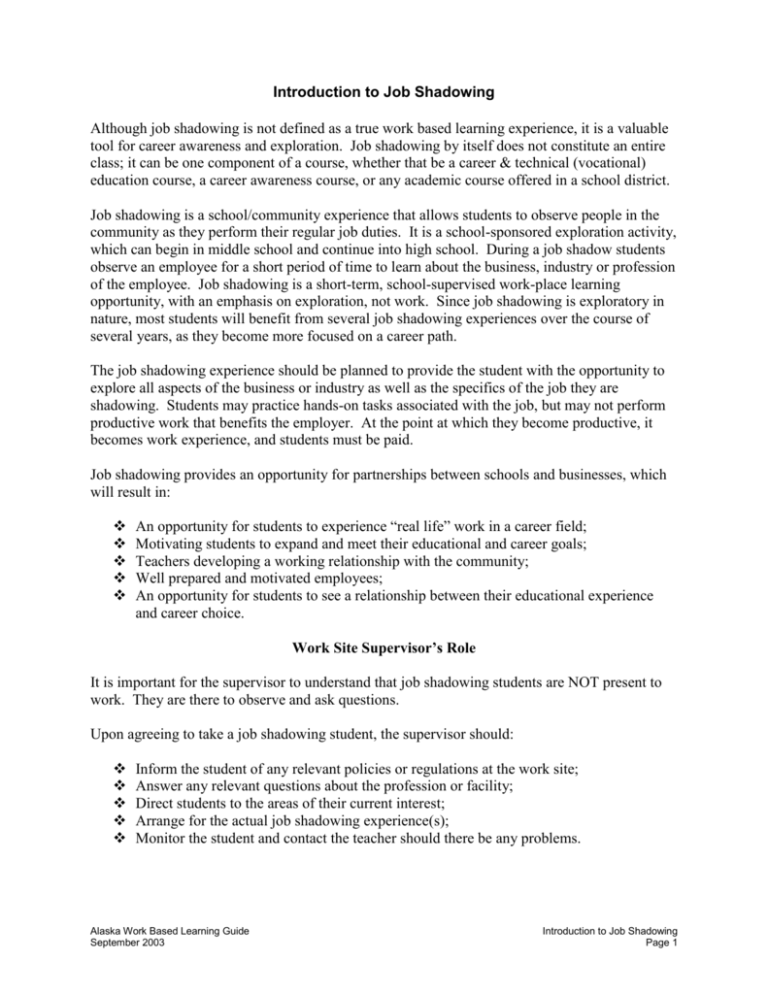Job Shadow Introduction - Alaska Department of Education
advertisement

Introduction to Job Shadowing Although job shadowing is not defined as a true work based learning experience, it is a valuable tool for career awareness and exploration. Job shadowing by itself does not constitute an entire class; it can be one component of a course, whether that be a career & technical (vocational) education course, a career awareness course, or any academic course offered in a school district. Job shadowing is a school/community experience that allows students to observe people in the community as they perform their regular job duties. It is a school-sponsored exploration activity, which can begin in middle school and continue into high school. During a job shadow students observe an employee for a short period of time to learn about the business, industry or profession of the employee. Job shadowing is a short-term, school-supervised work-place learning opportunity, with an emphasis on exploration, not work. Since job shadowing is exploratory in nature, most students will benefit from several job shadowing experiences over the course of several years, as they become more focused on a career path. The job shadowing experience should be planned to provide the student with the opportunity to explore all aspects of the business or industry as well as the specifics of the job they are shadowing. Students may practice hands-on tasks associated with the job, but may not perform productive work that benefits the employer. At the point at which they become productive, it becomes work experience, and students must be paid. Job shadowing provides an opportunity for partnerships between schools and businesses, which will result in: An opportunity for students to experience “real life” work in a career field; Motivating students to expand and meet their educational and career goals; Teachers developing a working relationship with the community; Well prepared and motivated employees; An opportunity for students to see a relationship between their educational experience and career choice. Work Site Supervisor’s Role It is important for the supervisor to understand that job shadowing students are NOT present to work. They are there to observe and ask questions. Upon agreeing to take a job shadowing student, the supervisor should: Inform the student of any relevant policies or regulations at the work site; Answer any relevant questions about the profession or facility; Direct students to the areas of their current interest; Arrange for the actual job shadowing experience(s); Monitor the student and contact the teacher should there be any problems. Alaska Work Based Learning Guide September 2003 Introduction to Job Shadowing Page 1 Student Expectations As part of the job shadowing experience, students should: Dress according to the standards of the particular site; Call the site before the scheduled time if unable to attend on the appointed day; Arrive at the site at the agreed upon time; Follow all guidelines and policies of the site; Complete any school assignments related to the job shadowing experience; Complete all required paperwork (permission, medical authorizations, etc.). Examples of the kinds of assignments students may be asked to complete as a result of their job shadow: Written report on a specific career; Information about the job shadowing site: (emergency procedures, site fire plan, diagram of the facility, site personnel names and titles within the company or department); Supervisor interview; A journal entry describing the site, the people, the work, and the environment; Classroom oral presentation or poster presentation on careers represented at the job shadowing site. Teacher’s or Coordinator’s Role The teacher or coordinator will be responsible to see that all students participating in the job shadowing experience have met all of the criteria required before the students are placed on job shadowing sites: The following are suggested duties and responsibilities of the teacher or coordinator for a jobshadowing experience. Ensure that job shadowing paperwork is completed; Check with your school district’s risk management section to ensure adequate insurance coverage; Schedule students and keep records of the student names, date of shadowing, sites, and supervisors; Follow-up with work sites for feedback on the job shadow; Monitor completion of student assignments; Be available in emergency situations. Job Shadowing Resources Sample forms beginning on the next page http://www.jobshadow.org Alaska Work Based Learning Guide September 2003 Introduction to Job Shadowing Page 2




